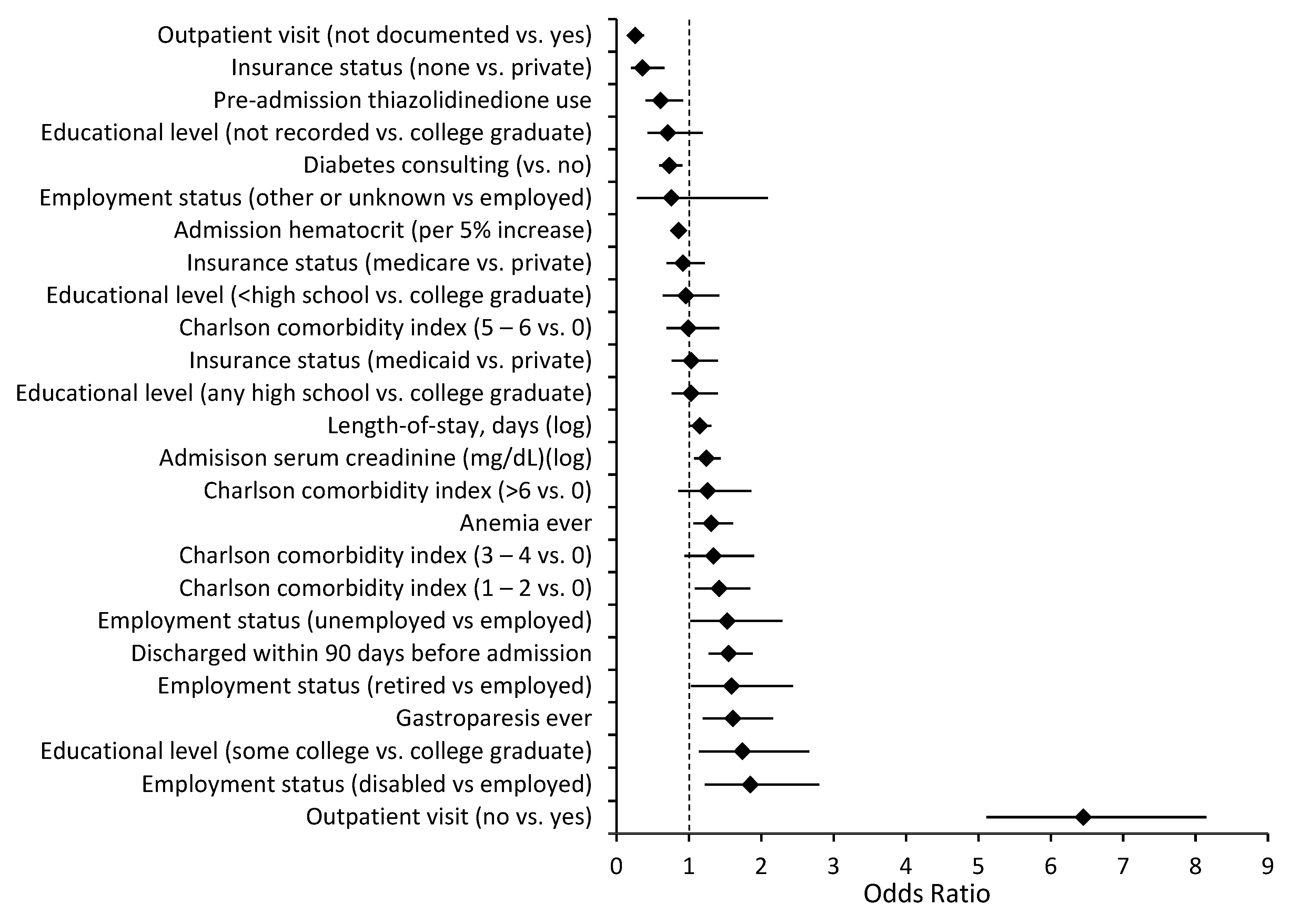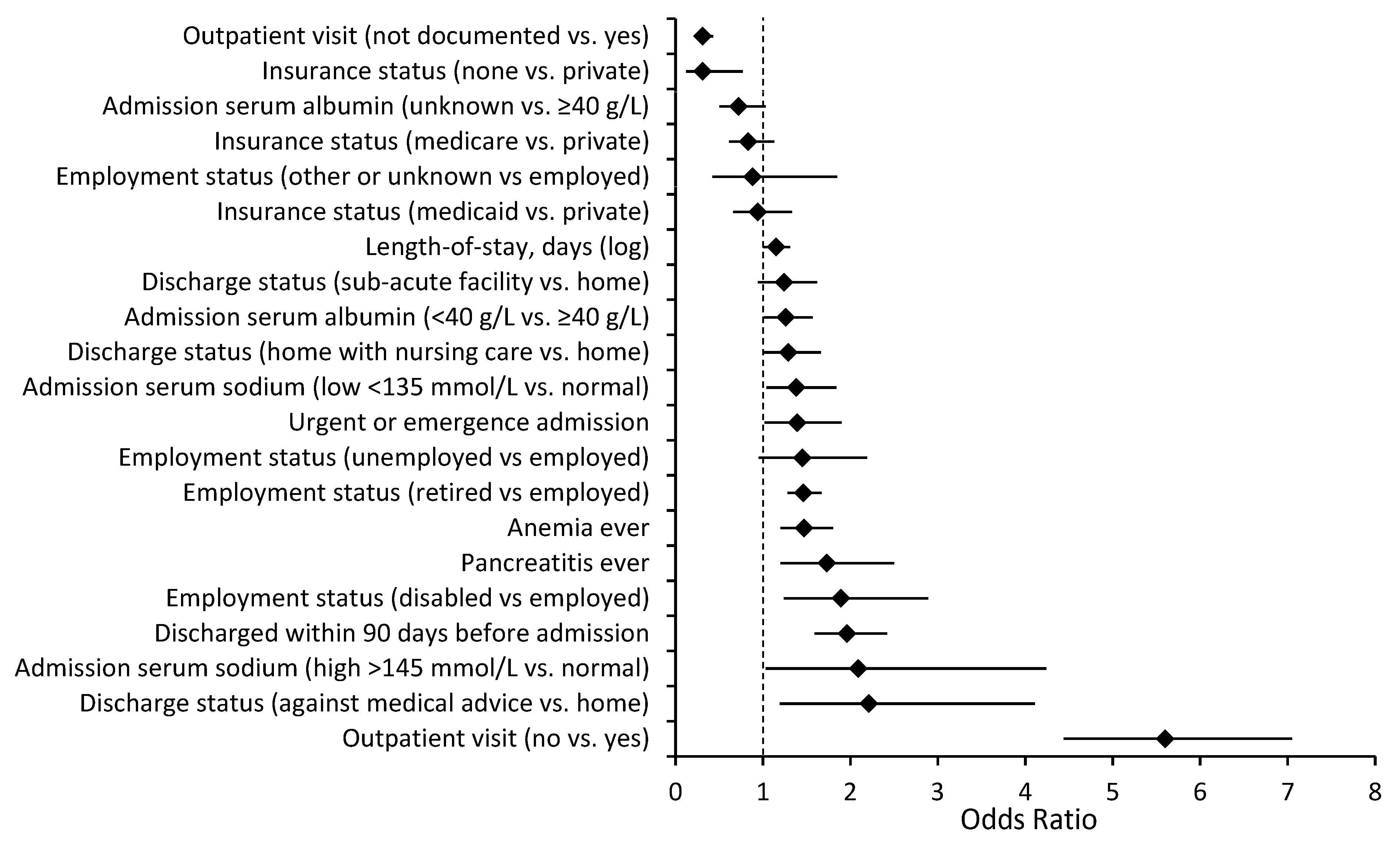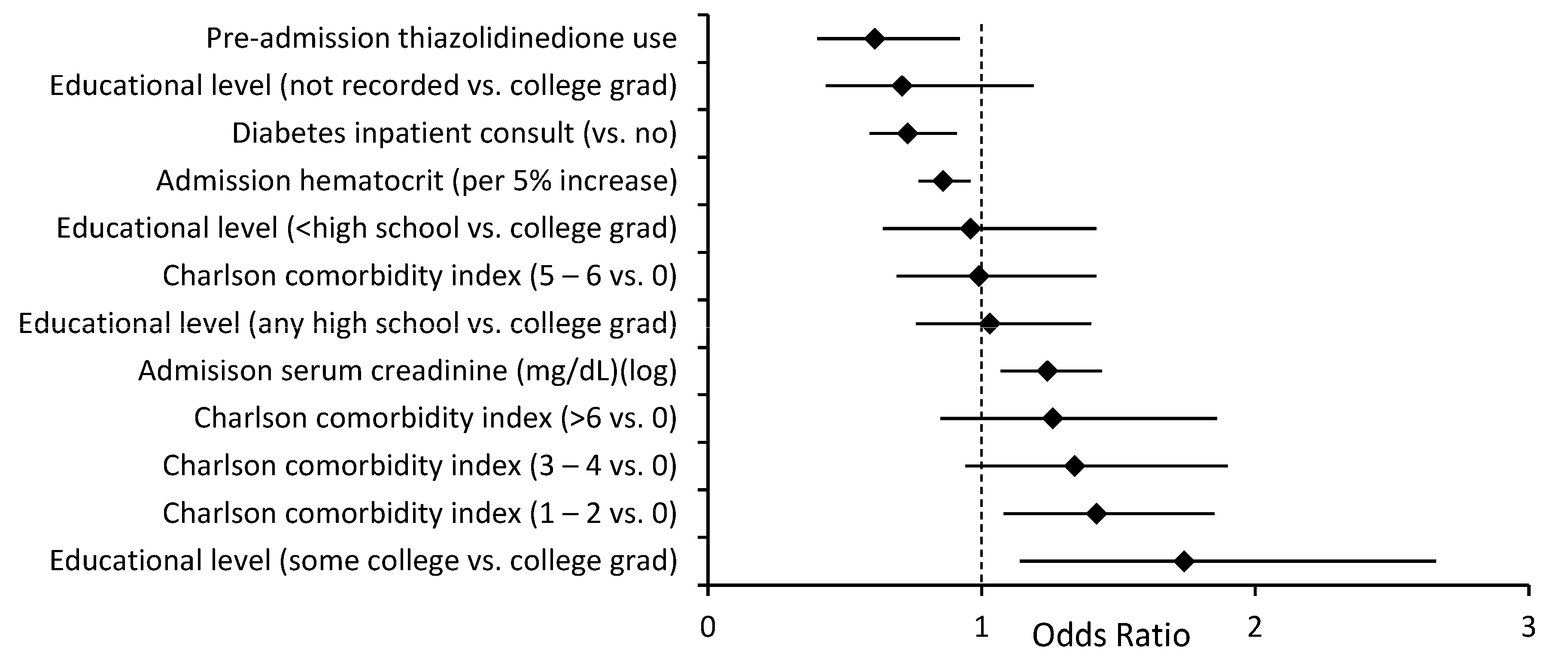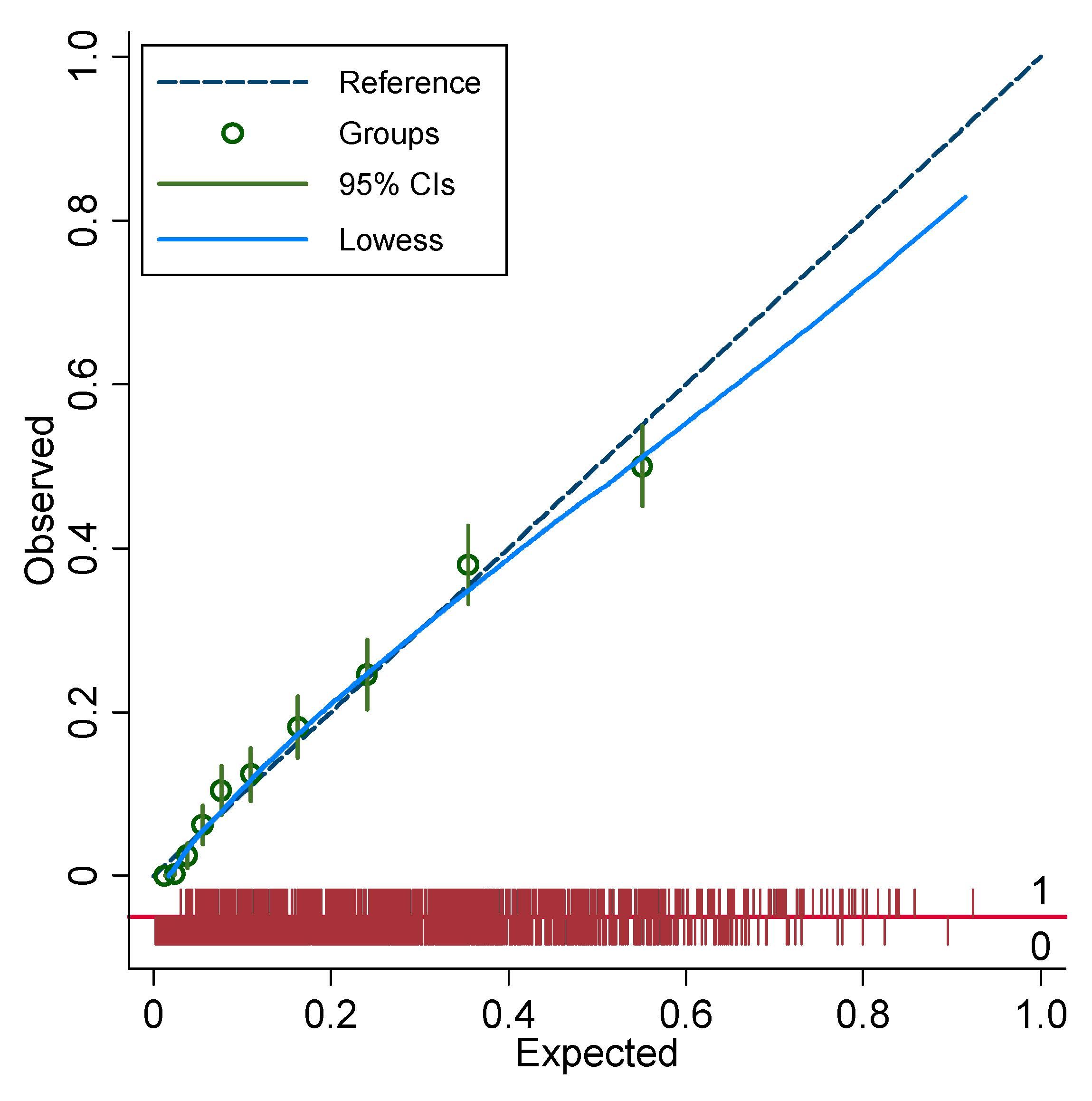Hospital Readmission Risk and Risk Factors of People with a Primary or Secondary Discharge Diagnosis of Diabetes
Abstract
1. Introduction
2. Methods
2.1. Study Sample
2.2. Definition of Variables and Outcomes
2.3. Statistical Analyses
3. Results
4. Discussion
Supplementary Materials
Author Contributions
Funding
Institutional Review Board Statement
Informed Consent Statement
Data Availability Statement
Conflicts of Interest
References
- Benbassat, J.; Taragin, M. Hospital readmissions as a measure of quality of health care: Advantages and limitations. Arch. Intern. Med. 2000, 160, 1074–1081. [Google Scholar] [CrossRef] [PubMed]
- Kocher, R.P.; Adashi, E.Y. Hospital readmissions and the affordable care act: Paying for coordinated quality care. JAMA 2011, 306, 1794–1795. [Google Scholar] [CrossRef] [PubMed]
- McIlvennan, C.K.; Eapen, Z.J.; Allen, L.A. Hospital readmissions reduction program. Circulation 2015, 131, 1796–1803. [Google Scholar] [CrossRef]
- Enomoto, L.M.; Shrestha, D.P.; Rosenthal, M.B.; Hollenbeak, C.S.; Gabbay, R.A. Risk factors associated with 30-day readmission and length of stay in patients with type 2 diabetes. J Diabetes Complicat. 2017, 31, 122–127. [Google Scholar] [CrossRef]
- Ostling, S.; Wyckoff, J.; Ciarkowski, S.L.; Pai, C.W.; Choe, H.M.; Bahl, V.; Gianchandani, R. The relationship between diabetes mellitus and 30-day readmission rates. journal article. Clin. Diabetes Endocrinol. 2017, 3, 3. [Google Scholar] [CrossRef]
- AHRQ. Healthcare Cost and Utilization Project (HCUP) National Inpatient Sample (NIS) 2018. Available online: https://hcupnet.ahrq.gov/#setup (accessed on 27 January 2022).
- Fingar, K.R.; Reid, L.D. Diabetes-Related Inpatient Stays, 2018; Agency for Healthcare Research and Quality (US): Rockville, MD, USA, 2021. [Google Scholar]
- Centers for Disease Control and Prevention. National Diabetes Statistics Report; U.S. Dept of Health and Human Services: Atlanta, GA, USA, 2020. [Google Scholar]
- Rubin, D.J.; Shah, A.A. Predicting and Preventing Acute Care Re-Utilization by Patients with Diabetes. Curr. Diabetes Rep. 2021, 21, 34. [Google Scholar] [CrossRef] [PubMed]
- Rubin, D.J. Hospital Readmission of Patients with Diabetes. Curr. Diabetes Rep. 2015, 15, 17. [Google Scholar] [CrossRef]
- Sonmez, H.; Kambo, V.; Avtanski, D.; Lutsky, L.; Poretsky, L. The readmission rates in patients with versus those without diabetes mellitus at an urban teaching hospital. J. Diabetes Complicat. 2017, 31, 1681–1685. [Google Scholar] [CrossRef]
- Karunakaran, A.; Zhao, H.; Rubin, D.J. Predischarge and Postdischarge Risk Factors for Hospital Readmission Among Patients With Diabetes. Med. Care 2018, 56, 634–642. [Google Scholar] [CrossRef]
- Furnival, G.M.; Wilson, R.W., Jr. Regressions by Leaps and Bounds. Technometrics 1974, 16, 499–511. [Google Scholar] [CrossRef]
- Hanley, J.A.; Negassa, A.; Edwardes, M.D.; Forrester, J.E. Statistical Analysis of Correlated Data Using Generalized Estimating Equations: An Orientation. Am. J. Epidemiol. 2003, 157, 364–375. [Google Scholar] [CrossRef] [PubMed]
- Hanley, J.A.; McNeil, B.J. The meaning and use of the area under a receiver operating characteristic (ROC) curve. Radiology 1982, 143, 29–36. [Google Scholar] [CrossRef] [PubMed]
- Steyerberg, E.W.; Vickers, A.J.; Cook, N.R.; Gerds, T.; Gonen, M.; Obuchowski, N.; Pencina, M.J.; Kattan, M. Assessing the performance of prediction models: A framework for traditional and novel measures. Research Support, Non-U.S. Gov’t. Epidemiology 2010, 21, 128–138. [Google Scholar] [CrossRef]
- Shaka, H.; Aguilera, M.; Aucar, M.; El-Amir, Z.; Wani, F.; Muojieje, C.C.; Kichloo, A. Rate and Predictors of 30-day Readmission Following Diabetic Ketoacidosis in Type 1 Diabetes Mellitus: A US Analysis. J. Clin. Endocrinol. Metab. 2021, 106, 2592–2599. [Google Scholar] [CrossRef]
- Koproski, J.; Pretto, Z.; Poretsky, L. Effects of an intervention by a diabetes team in hospitalized patients with diabetes. Diabetes Care. 1997, 20, 1553–1555. [Google Scholar] [CrossRef]
- Wang, Y.J.; Seggelke, S.; Hawkins, R.M.; Gibbs, J.; Lindsay, M.; Hazlett, I.; Wang, C.C.L.; Rasouli, N.; Young, K.A.; Draznin, B. Impact of glucose management team on outcomes of hospitalizaron in patients with type 2 diabetes admitted to the medical service. Endocr. Pract. 2016, 22, 1401–1405. [Google Scholar] [CrossRef]
- Mandel, S.R.; Langan, S.; Mathioudakis, N.N.; Sidhaye, A.R.; Bashura, H.; Bie, J.Y.; Mackay, P.; Tucker, C.; Demidowich, A.P.; Simonds, W.F.; et al. Retrospective study of inpatient diabetes management service, length of stay and 30-day readmission rate of patients with diabetes at a community hospital. J. Community Hosp. Intern. Med. Perspect. 2019, 9, 64–73. [Google Scholar] [CrossRef]
- Bansal, V.; Mottalib, A.; Pawar, T.K.; Abbasakoor, N.; Chuang, E.; Chaudhry, A.; Sakr, M.; Gabbay, R.A.; Hamdy, O. Inpatient diabetes management by specialized diabetes team versus primary service team in non-critical care units: Impact on 30-day readmission rate and hospital cost. BMJ Open Diabetes Res. Care 2018, 6, e000460. [Google Scholar] [CrossRef]
- Bhalodkar, A.; Sonmez, H.; Lesser, M.; Leung, T.; Ziskovich, K.; Inlall, D.; Murray-Bachmann, R.; Krymskaya, M.; Poretsky, L. The Effects of a Comprehensive Multidisciplinary Outpatient Diabetes Program on Hospital Readmission Rates in Patients with Diabetes: A Randomized Controlled Prospective Study. Endocr. Pract. 2020, 26, 1331–1336. [Google Scholar] [CrossRef]
- Seggelke, S.A.; Hawkins, R.M.; Gibbs, J.; Rasouli, N.; Wang, C.; Draznin, B. Transitional care clinic for uninsured and medicaid-covered patients with diabetes mellitus discharged from the hospital: A pilot quality improvement study. Hosp. Pract. 2014, 42, 46–51. [Google Scholar] [CrossRef]
- Magny-Normilus, C.; Nolido, N.V.; Borges, J.C.; Brady, M.; Labonville, S.; Williams, D.; Soukup, J.; Lipsitz, S.; Hudson, M.; Schnipper, J.L. Effects of an Intensive Discharge Intervention on Medication Adherence, Glycemic Control, and Readmission Rates in Patients With Type 2 Diabetes. J. Patient Saf. 2021, 17, 73–80. [Google Scholar] [CrossRef]
- Rubin, D.J.; Handorf, E.A.; Golden, S.H.; Nelson, D.B.; McDonnell, M.E.; Zhao, H. Development and Validation of a Novel Tool to Predict Hospital Readmission Risk Among Patients With Diabetes. Endocr. Pract. 2016, 22, 1204–1215. [Google Scholar] [CrossRef] [PubMed]
- Nana-Sinkam, P.; Kraschnewski, J.; Sacco, R.; Chavez, J.; Fouad, M.; Gal, T.; AuYoung, M.; Namoos, A.; Winn, R.; Sheppard, V.; et al. Health disparities and equity in the era of COVID-19. J. Clin. Transl. Sci. 2021, 5, e99. [Google Scholar] [CrossRef] [PubMed]
- Subramaniam, A.; Lim, Z.J.; Ponnapa Reddy, M.; Shekar, K. Systematic review and meta-analysis of the characteristics and outcomes of readmitted <scp>COVID</scp> -19 survivors. Intern. Med. J. 2021, 51, 1773–1780. [Google Scholar] [CrossRef] [PubMed]
- Klompas, M.; Eggleston, E.; McVetta, J.; Lazarus, R.; Li, L.; Platt, R. Automated Detection and Classification of Type 1 Versus Type 2 Diabetes Using Electronic Health Record Data. Diabetes Care 2013, 36, 914–921. [Google Scholar] [CrossRef]






| Variable | All Patients N = 8054 | Primary Diabetes Dx N = 4027 | Secondary Diabetes Dx N = 4027 | p Value |
|---|---|---|---|---|
| Age, N (%) | <0.0001 | |||
| <50 years | 2246 (27.9) | 1557 (38.7) | 689 (17.1) | |
| 50–59 years | 1890 (23.5) | 972 (24.1) | 918 (22.8) | |
| 60–69 years | 1808 (22.4) | 771 (19.1) | 1037 (25.8) | |
| 70+ years | 2110 (26.2) | 727 (18.1) | 1383 (34.3) | |
| Female, N (%) | 3796 (47.1) | 1757 (43.6) | 2039 (50.6) | 0.0004 |
| Marital status, a N (%) | <0.0001 | |||
| Married | 2337 (29.0) | 948 (23.5) | 1389 (34.5) | |
| Single | 5558 (69.0) | 3018 (74.9) | 2540 (63.1) | |
| Race/ethnicity, a N (%) | <0.0001 | |||
| Black | 3254 (40.4) | 1990 (49.4) | 1264 (31.4) | |
| Hispanic | 1008 (12.5) | 509 (12.6) | 499 (12.4) | |
| White | 1956 (24.3) | 785 (19.5) | 1171 (29.1) | |
| Not recorded | 1522 (18.9) | 616 (15.3) | 906 (22.5) | |
| English speaking, N (%) | 6569 (81.6) | 3409 (84.7) | 3160 (78.5) | <0.0001 |
| Insurance status, N (%) | <0.0001 | |||
| Medicaid | 1592 (19.8) | 948 (23.5) | 644 (16.0) | |
| Medicare | 2935 (36.4) | 1366 (33.9) | 1569 (39.0) | |
| None | 469 (5.8) | 334 (8.3) | 135 (3.4) | |
| Private | 1614 (20.0) | 780 (19.4) | 834 (20.7) | |
| Not recorded | 1444 (17.9) | 599 (14.9) | 845 (21.0) | |
| Home zip code < 5 mi. from hospital, N (%) | 5688 (70.6) | 3121 (77.5) | 2567 (63.7) | <0.0001 |
| Educational level, N (%) | <0.0001 | |||
| Less than high school | 1039 (12.9) | 503 (12.5) | 536 (13.3) | |
| Any high school | 4465 (55.4) | 2366 (58.8) | 2099 (52.1) | |
| Some college | 535 (6.6) | 294 (7.3) | 241 (6.0) | |
| College graduate | 1261 (15.7) | 571 (14.2) | 690 (17.1) | |
| Not recorded | 754 (9.4) | 293 (7.3) | 461 (11.4) | |
| Employment, a N (%) | <0.0001 | |||
| Disabled | 1742 (21.6) | 1033 (25.7) | 709 (17.6) | |
| Employed | 885 (11.0) | 410 (10.2) | 475 (11.8) | |
| Retired | 2536 (31.5) | 941 (23.4) | 1595 (39.6) | |
| Unemployed | 2635 (32.7) | 1551 (38.5) | 1084 (26.9) | |
| Pre-admission sulfonylurea use, N (%) | 1066 (13.2) | 408 (10.1) | 658 (16.3) | <0.0001 |
| Pre-admission metformin use, N (%) | 2029 (25.2) | 753 (18.7) | 1276 (31.7) | <0.0001 |
| Pre-admission insulin use, N (%) | 3404 (42.3) | 2216 (55.0) | 1188 (29.5) | <0.0001 |
| Steroids at admission | 595 (7.4) | 222 (5.5) | 373 (9.3) | <0.0001 |
| Most extreme blood glucose level, b N (%) | <0.0001 | |||
| 40–69 or 181–300 mg/dL | 3008 (37.3) | 1238 (30.7) | 1770 (44.0) | |
| 70–180 mg/dL | 2182 (27.1) | 502 (12.5) | 1680 (41.7) | |
| <40 or >300 mg/dL | 2864 (35.6) | 2287 (56.8) | 577 (14.3) | |
| Diabetes inpatient consultation, N (%) | 1854 (23.0) | 1438 (35.7) | 416 (10.3) | <0.0001 |
| Current or prior DKA or HHS, N (%) | 1471 (18.3) | 1416 (35.2) | 55 (1.4) | <0.0001 |
| Microvascular complications, c N (%) | <0.0001 | |||
| 0 | 5099 (63.3) | 1938 (48.1) | 3161 (78.5) | |
| 1 | 1781 (22.1) | 1164 (28.9) | 617 (15.3) | |
| 2 | 781 (9.7) | 588 (14.6) | 193 (4.8) | |
| 3 | 393 (4.9) | 337 (8.4) | 56 (1.4) | |
| Macrovascular complications, d N (%) | <0.0001 | |||
| 0 | 4207 (52.2) | 2346 (58.3) | 1861 (46.2) | |
| 1 | 2126 (26.4) | 967 (24.0) | 1159 (28.8) | |
| 2 | 1228 (15.2) | 447 (11.1) | 781 (19.4) | |
| 3 | 393 (4.9) | 217 (5.4) | 176 (4.4) | |
| 4 | 100 (1.2) | 50 (1.2) | 50 (1.2) | |
| Pre-admission blood pressure meds, N (%) | <0.0001 | |||
| None | 2743 (34.1) | 1521 (37.8) | 1222 (30.3) | |
| ACE-i or ARB | 3699 (45.9) | 1789 (44.4) | 1910 (47.4) | |
| Non-ACE or ARB | 1612 (20.0) | 717 (17.8) | 895 (22.2) | |
| Pre-admission statin use, N (%) | 3389 (42.1) | 1462 (36.3) | 1927 (47.9) | <0.0001 |
| Admission white blood cell count, N (%) | <0.0001 | |||
| Low < 4 K/μL | 387 (4.8) | 218 (5.4) | 169 (4.2) | |
| Normal 4–11 K/μL | 6278 (77.9) | 3228 (80.2) | 3050 (75.7) | |
| High > 11 K/μL | 1389 (17.2) | 581 (14.4) | 808 (20.1) | |
| Admission serum albumin, N (%) | <0.0001 | |||
| 4+ g/dL | 3116 (38.7) | 1722 (42.8) | 1394 (34.6) | |
| <4 g/dL | 4088 (50.8) | 1984 (49.3) | 2104 (52.2) | |
| Unknown | 850 (10.6) | 321 (8.0) | 529 (13.1) | |
| Admission serum sodium, N (%) | <0.0001 | |||
| Low < 135 mmol/L | 914 (11.3) | 533 (13.2) | 381 (9.5) | |
| Normal 135–145 mmol/L | 7078 (87.9) | 3470 (86.2) | 3608 (89.6) | |
| High > 145 mmol/L | 62 (0.8) | 24 (0.6) | 38 (0.9) | |
| Admission serum potassium, N (%) | <0.0001 | |||
| Low < 3.1 mmol/L | 95 (1.2) | 46 (1.1) | 49 (1.2) | |
| Normal 3.1–5.3 mmol/L | 7196 (89.3) | 3473 (86.2) | 3723 (92.5) | |
| High > 5.3 mmol/L | 763 (9.5) | 508 (12.6) | 255 (6.3) | |
| Admission creatinine (mg/dL), median (IQR) | 0.9 (0.7–1.3) | 1.0 (0.8–1.4) | 0.9 (0.7–1.3) | 0.0012 |
| Discharged 90 d before index admission, N (%) | 2390 (29.7) | 1335 (33.2) | 1055 (26.2) | <0.0001 |
| Year of discharge, N (%) | <0.0001 | |||
| 2004 | 805 (10.0) | 411 (10.2) | 394 (9.8) | |
| 2005 | 844 (10.5) | 464 (11.5) | 380 (9.4) | |
| 2006 | 878 (10.9) | 496 (12.3) | 382 (9.5) | |
| 2007 | 1048 (13.0) | 574 (14.3) | 474 (11.8) | |
| 2008 | 951 (11.8) | 507 (12.6) | 444 (11.0) | |
| 2009 | 1037 (12.9) | 494 (12.3) | 543 (13.5) | |
| 2010 | 1047 (13.0) | 482 (12.0) | 565 (14.0) | |
| 2011 | 788 (9.8) | 321 (8.0) | 467 (11.6) | |
| 2012 | 656 (8.1) | 278 (6.9) | 378 (9.4) | |
| Length-of-stay (days), median (IQR) | 3.3 (2.1–5.8) | 3.1 (2.0–5.1) | 3.6 (2.1–6.2) | <0.0001 |
| Urgent or emergent admission, N (%) | <0.0001 | |||
| No | 955 (11.9) | 318 (7.9) | 637 (15.8) | |
| Yes | 7099 (88.1) | 3709 (92.1) | 3390 (84.2) | |
| Yes | 1395 (17.3) | 717 (17.8) | 678 (16.8) | |
| No | 6659 (82.7) | 3310 (82.2) | 3349 (83.2) | |
| Blood transfusion given, N (%) | <0.0001 | |||
| Yes | 885 (11.0) | 319 (7.9) | 566 (14.1) | |
| No | 7169 (89.0) | 3708 (92.1) | 3461 (85.9) | |
| Parenteral or enteral nutrition, N (%) | <0.0001 | |||
| Yes | 180 (2.2) | 43 (1.1) | 137 (3.4) | |
| No | 7874 (97.8) | 3984 (98.9) | 3890 (96.6) | |
| Discharge status of index admission, a N (%) | 0.0024 | |||
| Home | 4909 (61.0) | 2475 (61.5) | 2434 (60.4) | |
| Home with nursing care | 1550 (19.2) | 786 (19.5) | 764 (19.0) | |
| Sub-acute facility | 1363 (16.9) | 628 (15.6) | 735 (18.3) | |
| Against medical advice | 190 (2.4) | 121 (3.0) | 69 (1.7) | |
| Discharge 1 year prior to index admission, N (%) | <0.0001 | |||
| Home | 2852 (35.4) | 1562 (38.8) | 1290 (32.0) | |
| Home with nursing care | 923 (11.5) | 473 (11.7) | 450 (11.2) | |
| Sub-acute facility | 774 (9.6) | 383 (9.5) | 391 (9.7) | |
| Against medical advice | 133 (1.7) | 90 (2.2) | 43 (1.1) | |
| No discharge recorded | 3372 (41.9) | 1519 (37.7) | 1853 (46.0) | |
| Body mass index, N (%) | <0.0001 | |||
| <18.5 kg/m2 | 182 (2.3) | 113 (2.8) | 69 (1.7) | |
| 18.5–24.9 kg/m2 | 1587 (19.7) | 971 (24.1) | 616 (15.3) | |
| 25.0–29.9 kg/m2 | 2223 (27.6) | 1082 (26.9) | 1141 (28.3) | |
| ≥30.0 kg/m2 | 4062 (50.4) | 1861 (46.2) | 2201 (54.7) | |
| Depression or psychosis ever, N (%) | 2438 (30.3) | 1358 (33.7) | 1080 (26.8) | 0.0002 |
| Gastroparesis ever, N (%) | 683 (8.5) | 596 (14.8) | 87 (2.2) | <0.0001 |
| Pancreatitis ever, N (%) | 410 (5.1) | 246 (6.1) | 164 (4.1) | 0.037 |
| Hypertension ever, N (%) | 5630 (69.9) | 2631 (65.3) | 2999 (74.5) | <0.0001 |
| COPD or asthma ever, N (%) | 1551 (19.3) | 625 (15.5) | 926 (23.0) | <0.0001 |
| Cardiac dysrhythmias ever, N (%) | 1431 (17.8) | 492 (12.2) | 939 (23.3) | <0.0001 |
| Malignant neoplasm ever, N (%) | 596 (7.4) | 140 (3.5) | 456 (11.3) | <0.0001 |
| Drug abuse, N (%) | <0.0001 | |||
| Never | 6262 (77.8) | 2990 (74.2) | 3272 (81.3) | |
| History | 1403 (17.4) | 786 (19.5) | 617 (15.3) | |
| Current | 389 (4.8) | 251 (6.2) | 138 (3.4) | |
| Current complication of device, graft, or implant, N (%) | <0.0001 | |||
| Yes | 208 (2.6) | 53 (1.3) | 155 (3.8) | |
| Current fluid or electrolyte disorder, N (%) | 1695 (21.0) | 969 (24.1) | 726 (18.0) | <0.0001 |
| Charlson comorbidity index, N (%) | <0.0001 | |||
| 0 | 1271 (15.8) | 1269 (31.5) | 2 (0.0) | |
| 1–2 | 2211 (27.5) | 914 (22.7) | 1297 (32.2) | |
| 3–4 | 1503 (18.7) | 508 (12.6) | 995 (24.7) | |
| 5–6 | 791 (9.8) | 370 (9.2) | 421 (10.5) | |
| >6 | 2278 (28.3) | 966 (24.0) | 1312 (32.6) | |
| Outpatient visit, N (%) | <0.0001 | |||
| Yes | 3683 (45.7) | 1820 (45.2) | 1863 (46.3) | |
| No | 2303 (28.6) | 1239 (30.8) | 1064 (26.4) | |
| Unknown | 2068 (25.7) | 968 (24.0) | 1100 (27.3) |
Disclaimer/Publisher’s Note: The statements, opinions and data contained in all publications are solely those of the individual author(s) and contributor(s) and not of MDPI and/or the editor(s). MDPI and/or the editor(s) disclaim responsibility for any injury to people or property resulting from any ideas, methods, instructions or products referred to in the content. |
© 2023 by the authors. Licensee MDPI, Basel, Switzerland. This article is an open access article distributed under the terms and conditions of the Creative Commons Attribution (CC BY) license (https://creativecommons.org/licenses/by/4.0/).
Share and Cite
Rubin, D.J.; Maliakkal, N.; Zhao, H.; Miller, E.E. Hospital Readmission Risk and Risk Factors of People with a Primary or Secondary Discharge Diagnosis of Diabetes. J. Clin. Med. 2023, 12, 1274. https://doi.org/10.3390/jcm12041274
Rubin DJ, Maliakkal N, Zhao H, Miller EE. Hospital Readmission Risk and Risk Factors of People with a Primary or Secondary Discharge Diagnosis of Diabetes. Journal of Clinical Medicine. 2023; 12(4):1274. https://doi.org/10.3390/jcm12041274
Chicago/Turabian StyleRubin, Daniel J., Naveen Maliakkal, Huaqing Zhao, and Eli E. Miller. 2023. "Hospital Readmission Risk and Risk Factors of People with a Primary or Secondary Discharge Diagnosis of Diabetes" Journal of Clinical Medicine 12, no. 4: 1274. https://doi.org/10.3390/jcm12041274
APA StyleRubin, D. J., Maliakkal, N., Zhao, H., & Miller, E. E. (2023). Hospital Readmission Risk and Risk Factors of People with a Primary or Secondary Discharge Diagnosis of Diabetes. Journal of Clinical Medicine, 12(4), 1274. https://doi.org/10.3390/jcm12041274







